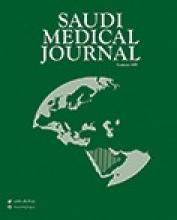To the Editor
We read with interest the article by Qureshi et al.1 In their report, the authors presented a case of adult onset Still’s disease (AOSD) associated with the rather atypical manifestation of dermatopathic lymphadenopathy. We would like to emphasise on the point that AOSD may, indeed, sometimes be associated with unusual features that are not traditionally included in the usual classification criteria. The diagnosis of AOSD relies on the fulfilment of a set of criteria; once infectious, autoimmune rheumatic, and neoplastic causes had been ruled out. The Yamaguchi criteria are the most commonly applied by clinicians and have a sensitivity of 96.2% and a specificity of 92.1%. These criteria are divided into major criteria (fever, arthralgia / arthritis, typical salmon pink rash, and neutrophil leukocytosis) and minor criteria (sore throat, lymphadenopathy, hepatomegaly and/or splenomegaly, abnormal liver function tests and negative rheumatoid factor and antinuclear antibody). Diagnosis requires 5 criteria with at least 2 major criteria. Indeed there are reports of other forms of lymph node involvement in addition to dermatopathic lymphadenopathy reported in this case report. In most cases of AOSD, the usual lymph node histology demonstrates reactive hyperplasia. Assimakopoulos et al2 reported a case of suppurative necrotizing granulomatous lymphadenitis, and Koeller et al3 reported a case of destructive lymphadenopathy in patients with AOSD.
Other manifestations not included in the Yamaguchi criteria are also increasingly reported. In a recent retrospective review of 71 patients with AOSD, 5 patients were reported to have interstitial lung disease, 2 patients had acute respiratory distress syndrome, 3 patients had pericarditis, 6 patients had pleuritis, 5 patients had haemophagocytic syndrome, four patients had disseminated intravascular coagulation, one patient had thrombotic thrombocytopenic purpura and one patient had secondary amyloidosis.4 Other rare manifestations also include myocarditis, aseptic meningitis,5 pulmonary hypertension, and diffuse alveolar haemorrhage.6 Recently, small vessel vasculitis was also reported in association with AOSD.7
It is not unusual for the experienced clinician to come across a case with symptoms suggestive of AOSD and not find any other diagnostic alternative through the usual screening (infection, malignancy and systemic autoimmune diseases). There are some rare, sometimes even life threatening, syndromes that may present with multisystem symptoms identical to autoimmune rheumatic diseases and may get labelled as AOSD, yet be missed through the usual screening tests. We therefore would like to stress the importance of keeping these uncommon syndromes in mind.
Many rheumatic diseases are rare by nature and the time of presentation to diagnosis may take years in some situations. Additionally, rheumatology is becoming an expanding discipline and rheumatologists are increasingly being asked to see patients with even rarer disorders of multisystem nature that do not fit a particular rheumatic diagnosis or any recognisable pattern. Lack of awareness of such multisystem disorders may result in many unnecessary and expensive tests that may or may not reveal the underlying diagnosis. Thus, awareness and consideration of such entities is both detrimental to the effective use of healthcare resources and optimal patient management and patient safety.
Among these diagnoses is Schnitzler syndrome, which has many features of AOSD and may easily be misdiagnosed as AOSD if not specifically considered. Gaucher’s disease is another condition that has many clinical features of AOSD including splenomegaly, hepatomegaly, elevated transaminases, fever, and joint pain that could sometimes be mislabelled as AOSD. Furthermore, Gaucher’s disease is associated with a high ferritin level, thus adding to the diagnostic confusion. Finally, multicentric Castleman’s disease also manifests several of AOSD manifestations and may be misdiagnosed as AOSD. These potential diagnoses should be kept in mind if there is any doubt regarding the diagnosis of AOSD.
Reply from the Author
Dr. Adwan and Dr. Bakri have provided some interesting supplemental information, which is not emphasized much in the literature. The presence of lymphadenopathy in AOSD prompts the inclusion of malignancy in differential diagnosis; however, less attention is given to similar pathologies including Schnitzler syndrome or Gaucher’s disease in clinical practice, both of which are also associated with lymphadenopathy.8,9,10 Our case report is distinct due to the presence of dermatopathic lymphadenopathy, which is not reported in Schnitzler or Gaucher’s disease.1 The case report was intended to discuss AOSD in setting of dermatopathic lymphadenopathy. It is interesting to know that there are manifestations outside the Yamaguchi criteria, which can facilitate the diagnosis of AOSD as pointed out by Dr. Adwan and Dr. Bakri in their correspondence.
Ahmad Z. Qureshi
Department of Physical Medicine and Rehabilitation, King Fahad Medical City, Riyadh, Kingdom of Saudi Arabia
Case Reports
Case reports will only be considered for unusual topics that add something new to the literature. All Case Reports should include at least one figure. Written informed consent for publication must accompany any photograph in which the subject can be identified. Figures should be submitted with a 300 dpi resolution when submitting electronically. The abstract should be unstructured, and the introductory section should always include the objective and reason why the author is presenting this particular case. References should be up to date, preferably not exceeding 15.
- Copyright: © Saudi Medical Journal
This is an open-access article distributed under the terms of the Creative Commons Attribution-Noncommercial-Share Alike 3.0 Unported, which permits unrestricted use, distribution, and reproduction in any medium, provided the original work is properly cited.






